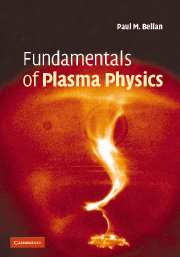Book contents
- Frontmatter
- Contents
- Preface
- 1 Basic concepts
- 2 The Vlasov, two-fluid, and MHD models of plasma dynamics
- 3 Motion of a single plasma particle
- 4 Elementary plasma waves
- 5 Streaming instabilities and the Landau problem
- 6 Cold plasma waves in a magnetized plasma
- 7 Waves in inhomogeneous plasmas and wave-energy relations
- 8 Vlasov theory of warm electrostatic waves in a magnetized plasma
- 9 MHD equilibria
- 10 Stability of static MHD equilibria
- 11 Magnetic helicity interpreted and Woltjer–Taylor relaxation
- 12 Magnetic reconnection
- 13 Fokker–Planck theory of collisions
- 14 Wave–particle nonlinearities
- 15 Wave–wave nonlinearities
- 16 Non-neutral plasmas
- 17 Dusty plasmas
- Appendices
- Bibliography and suggested reading
- References
- Index
17 - Dusty plasmas
Published online by Cambridge University Press: 05 June 2012
- Frontmatter
- Contents
- Preface
- 1 Basic concepts
- 2 The Vlasov, two-fluid, and MHD models of plasma dynamics
- 3 Motion of a single plasma particle
- 4 Elementary plasma waves
- 5 Streaming instabilities and the Landau problem
- 6 Cold plasma waves in a magnetized plasma
- 7 Waves in inhomogeneous plasmas and wave-energy relations
- 8 Vlasov theory of warm electrostatic waves in a magnetized plasma
- 9 MHD equilibria
- 10 Stability of static MHD equilibria
- 11 Magnetic helicity interpreted and Woltjer–Taylor relaxation
- 12 Magnetic reconnection
- 13 Fokker–Planck theory of collisions
- 14 Wave–particle nonlinearities
- 15 Wave–wave nonlinearities
- 16 Non-neutral plasmas
- 17 Dusty plasmas
- Appendices
- Bibliography and suggested reading
- References
- Index
Summary
Introduction
Non-neutral plasmas had one less species than a conventional plasma (one species instead of two); dusty plasmas have one more species (three species instead of two). Not surprisingly, the addition of another species provides new freedoms, which give rise to new behaviors.
The third species in a dusty plasma, electrically charged dust grains, typically have a charge to mass ratio quite different from that of electrons or ions. Several methods for charging dust grains are possible. Electron bombardment is the usual means for charging laboratory dusty plasmas, but photoionization or radioactive decay could also be operative mechanisms and may be important for certain space and astrophysical situations. Photoionization would make dust grains positive because photoionization causes electrons to leave dust grains. Radioactive decay of dust grains would make the dust grains develop a polarity opposite to that of the particle emitted in the decay process, e.g., alpha particle emission by dust grains would make the dust grains negative.
We shall consider here only the typical laboratory dusty plasma situation where the plasma is weakly ionized and dust grain charging is due to electron bombardment. Negative charging occurs because the electrons, being much lighter than the ions and usually much hotter, have a much larger thermal velocity than the ions. As a result, when a dust grain is inserted into the plasma it is initially subject to a greater flux of impacting electrons than impacting ions, thereby causing the dust grain to become negatively charged.
- Type
- Chapter
- Information
- Fundamentals of Plasma Physics , pp. 556 - 581Publisher: Cambridge University PressPrint publication year: 2006
- 1
- Cited by



